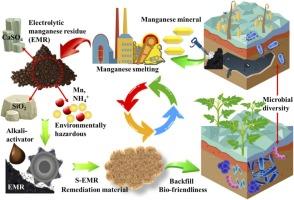Activated electrolytic manganese residue-based environmental materials for mine remediation: Performance and mechanism
IF 12.2
1区 环境科学与生态学
Q1 ENGINEERING, ENVIRONMENTAL
引用次数: 0
Abstract
To address the environmental hazards of electrolytic manganese residue (EMR) accumulation and the urgent need for ecological restoration in mining areas, we developed an innovative method for creating pit restoration materials (S-EMRs) using alkaline-excited EMR via mechanical ball milling. Black liquid (BL) was used as a base exciter and EMR as the precursor. With a BL dosage of 35%, alumina as the milling medium, a speed of 500 rpm, and milling for 20–35 min, we achieved an S-EMR compressive strength of approximately 30 MPa after 14 d—six times higher than that in conventional cement curing (C-EMR). This method also stabilized contaminants such as Mn and NH4+ by over 10-fold. The self-cementation and formation mechanisms of the S-EMR were clarified through chemical characterization and geochemical modeling. Over 3 y of monitoring and plant experiments have shown that S-EMR ensured the long-term stability and ecological restoration of mining areas. Remarkably, it enhanced microbial diversity and biophilicity, improving tomato seed germination by over 90% compared with that in control. This study presents a sustainable and innovative solution for the green cycle rehabilitation of Mn mining areas with significant potential for engineering applications.

基于活性电解锰渣的矿山修复环境材料:性能和机理
本文章由计算机程序翻译,如有差异,请以英文原文为准。
求助全文
约1分钟内获得全文
求助全文
来源期刊

Journal of Hazardous Materials
工程技术-工程:环境
CiteScore
25.40
自引率
5.90%
发文量
3059
审稿时长
58 days
期刊介绍:
The Journal of Hazardous Materials serves as a global platform for promoting cutting-edge research in the field of Environmental Science and Engineering. Our publication features a wide range of articles, including full-length research papers, review articles, and perspectives, with the aim of enhancing our understanding of the dangers and risks associated with various materials concerning public health and the environment. It is important to note that the term "environmental contaminants" refers specifically to substances that pose hazardous effects through contamination, while excluding those that do not have such impacts on the environment or human health. Moreover, we emphasize the distinction between wastes and hazardous materials in order to provide further clarity on the scope of the journal. We have a keen interest in exploring specific compounds and microbial agents that have adverse effects on the environment.
 求助内容:
求助内容: 应助结果提醒方式:
应助结果提醒方式:


